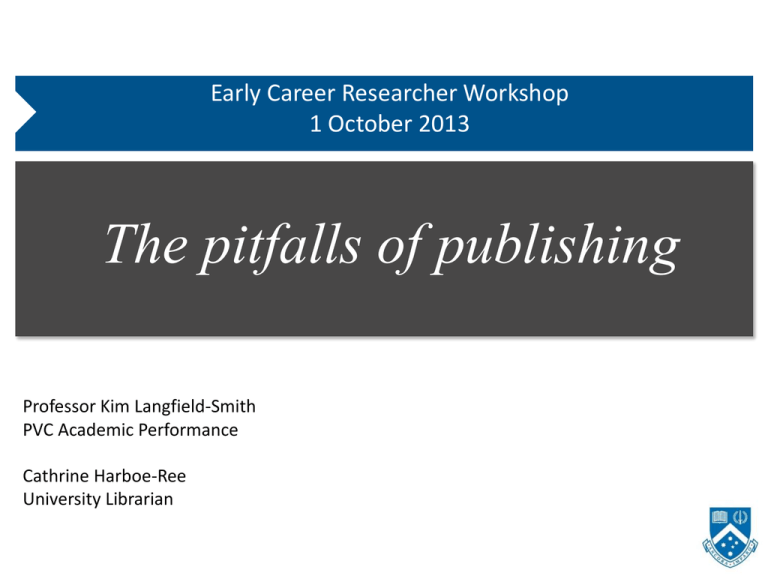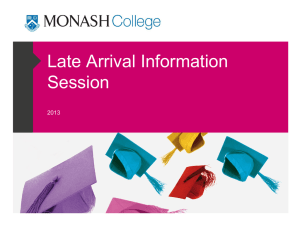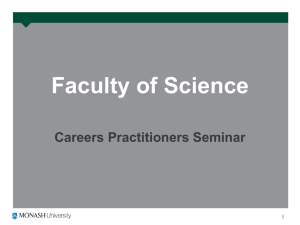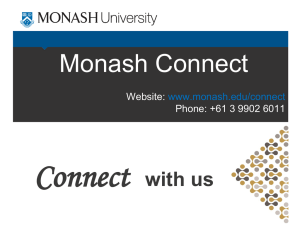Pitfalls of publishing
advertisement

Early Career Researcher Workshop 1 October 2013 The pitfalls of publishing Professor Kim Langfield-Smith PVC Academic Performance Cathrine Harboe-Ree University Librarian Workshop outline 1. 2. 3. 4. 5. 6. 7. 8. Scholarly communication Monash’s aspirations Quality versus quantity Research impact The national context Open access Monash infrastructure Focussing on you 2 1. Scholarly communication • “The process by which scholars conduct their research and make the results of their work known… • ... It is critical to the advancement of knowledge and a scholar’s career.” Mary M. Case, ‘Igniting Change in Scholarly Communication: SPARC, Its Past, Present and Future’, Advances in Librarianship, 26, 2002. [online] http://www.arl.org/sparc/SPARC_Advances.pdf. • … and to Monash University’s success. Journal articles Chapters Books Conference papers Working papers Presentations Artworks/performances Patents Research data? 87% of Monash’s submitted evidence for the ERA is scholarly communication by publication 3 Scholarly communication options Publish well Publish often Publish early Publish open access ? Publish for impact Publish innovatively 4 2. Monash’s aspirations for 2022 Monash University: The next ten years sets out three key goals for Monash to achieve, namely, that by 2022 Monash will be: 1. The best University within the Asia Pacific region 2. A truly global university, both physically and intellectually 3. Among the strongest research universities in the world 5 Some of our recent achievements Times Higher Education Rankings: 2010/11 to 2012/13 University of Melbourne vs Monash University ERA results: Closing the gap 200 150 4-Digit Ratings UMelb 2010 UMelb 2012 Monash 2010 Monash 2012 Monash 100 Go7 average 50 5 42 30 16 22 4 40 46 35 38 3 20 21 27 29 2 1 1 10 1 1 0 0 1 0 Ranking 5 1 3 6 6 Ranking 5/4 1 1 5 4 10/11 11/12 12/13 2009 to 2011 Research Income Growth 30% 25% 20% 15% 10% 5% 0% Monash Go7 6 International rankings 2013 QS World University Rankings • International ranking: 69 • Australian ranking: 6 2013 Times Higher Education Reputational Rankings • International ranking: 99 • Australian ranking: 6 2013 Academic Ranking of World Universities: • International ranking: 134 • Australian ranking: 7 7 Monash Research Strategy Six Pillars to support Six Pillars GOAL: Generating impact through excellent and relevant research 8 3. Quality vs quantity • Quality – ERA – NOT vanity publishing • Quantity – HERDC – Career development • Where should I publish? How much should I publish? • Why is it important to publish in a “quality” journal or book? 9 The importance of Quality • Why is it important to publish in a “quality” journal or book? – – – – – More rigorous reviewing process More likely to be read – and cited More likely to add to your reputation and profile More likely to contribute to the literature Good for your career!! • How do you identify a quality journal or book publisher? – – – – Discipline-based journal lists Journal impact factors Acceptance rates Ask your colleagues 10 Vanity and predatory publishing • • • • • No or diminished quality controls Not always honest about advisory boards, etc Always make the author pay all or most of the costs http://monash.edu/library/about/ul-vanity-publishing.pdf http://scholarlyoa.com/2012/12/06/bealls-list-of-predatorypublishers-2013/ • Don’t fall for their trap!! 11 4. What is research impact? The impact that research has had more widely on society … on the academic discipline, but also on policy, awareness, institutional and artistic practice, and commercial, economic, social and cultural benefit … (CHASS, 2005, p. 10) an effect on, change or benefit to the economy, society, culture, public policy or services, health, the environment or quality of life, beyond academia … impacts can be manifest in a wide variety of ways, may take many forms and occur in a wide range of spheres, in any geographic location (REF 2014) Academic impact - on other researchers Social, economic etc. impact - on business, government, society - contribution to discipline knowledge 12 Monash Research Strategy Six Pillars to support Six Pillars GOAL: Generating impact through excellent and relevant research 13 An increasing global focus on assessing research impact PBRF 14 Examples of economic and social impact Improved health or welfare outcomes Enhanced professional standards, ethics, guidelines or training Changes to the design or delivery of the school curriculum More effective management or workplace practices Improved quality, accessibility or efficiency of a public service Policy debate or decisions have been influenced or shaped by research Enhanced corporate social responsibility policies A new product has been commercialised Public debate has been shaped or informed by research Changes to legislation or regulations Enhanced preservation, conservation or presentation of cultural heritage Jobs have been created or protected Improved management or conservation of natural resources Improved access to justice, employment or education Production costs have reduced Improved risk management Research has informed public understanding, values, attitudes or behaviours Improved forensic methods or expert systems New forms of artistic expressions or changes to creative practice A social enterprise initiative has been created Changes in professional practice Levels of waste have reduced Improved business performance Enhanced teaching 15 standards or protocols Academic impact Managing citation performance • Citations as an indicator of impact/quality • Web of Knowledge (TR) vs Scopus vs Google scholar • Tracking your citations and citation performance • Bibliometric indicators – h-index, normalised citations, etc • Author citation alerts • Increasing the visibility of your citation performance – ResearcherId (Thomson Reuters) – Google scholar profiles http://scholar.google.com.au/citations?user=kUqSskcAAAAJ&hl=en 16 Thomson Reuters Citation Report Why is impact important? Research is central to what we do at Monash University. Since our establishment just over 50 years ago, we have become known for producing research that has an influence well beyond the academic community. • Underlying rationale for doing research – to make a difference • Accountability to research funders • Assist you in gaining increased research funding • Increase your reputation in the research community and beyond • Progress your career! 18 Improving your research impact Academic impact • International collaborations, multiple authors, multi-disciplinary teams • Article title, abstract, key words • On-line research sites and profiling Economic and social impact • Demand driven vs supply driven approaches vs partnerships • The big issues - multi-disciplinary teams • Social networking, blogs, media • Govt panels, consultancies, public presentations 19 5. National context • Quantity (HERDC) • Quality (ERA) • Open scholarship (Code for the Responsible Conduct of Research, NHMRC and ARC guidelines) • Impact (under consideration) • Quandary: – Does the Government want quality, which encourages conservatism and delays in publishing, or openness, which they do not reward, or impact, which is not yet defined? 20 Code for the responsible conduct of research • http://www.nhmrc.gov.au/_files_nhmrc/publications/a ttachments/r39.pdf • “Researchers have a responsibility to their colleagues and the wider community to disseminate a full account of their research as broadly as possible.” • “There are many ways of disseminating research findings. Formal publication of the results of research will usually take place in academic journals or books, but this is not always the case. The Code applies to all forms of dissemination, including, including nonrefereed publications … web pages … exhibitions … films … repositories.” 21 Code for the responsible conduct of research – cont • Responsibilities of researchers – – – – – – – – – Disseminate all research findings Ensure accuracy Cite the work of other authors fully and accurately Don’t publish findings multiple times Obtain permission for republishing Disclose research support accurately Register clinical trials Manage confidentiality Responsibly communicate research in the public arena 22 6. Open access • Desire to share research outputs – To improve research – To provide a public good • Attack on traditional publishing models – Cost – Time to publish • Now being mandated by NHMRC, ARC and overseas funding agencies 23 Desire to share research outputs • arXiv (http://arxiv.org – Established 1991 – Hosted by Cornell University – Nearly 800,000 physics, etc papers • Various for profit and not for profit efforts since then 24 Attack on traditional publishing • Traditional STM publishing yields outrageous profit margins – Elsevier: 38% – Springer: 34% – Wiley-Blackwell: 42.5% • Researchers provide content free, and also review other people’s content and edit journals for little or no recompense • The publishing process can take years 25 Publisher activity • Publishers have been vehemently opposed, but are now offering “green” and “gold” options – Green = author can self-archive – Gold = author pays the publisher for open access, either in repository or in a journal – Hybrid Gold = author pays for open access in a closed access journal • Increasing number of open access journals, of varying quality – Eg BioMed Central 26 Open access: NHMRC and ARC • Policies that require publications arising from funded research to be made open access within 12 months of acceptance (NHMRC) or publication (ARC), or … • … explain why not • Not expected to breach contractual arrangements or pay for open access • The University (Research Office and Library) are preparing information about this • You do not have to pay to comply – Do not pay for open access unless that is where you want to publish anyway 27 Monash’s approach to OA • Very supportive of the principle of open access – Monash University Publishing – Monash University Research Repository – Research data – ANDS • Philosophy: concentrate on making otherwise inaccessible research outputs available • More concerned about quality publishing than open access of journal articles 28 7. Monash infrastructure • Faculty Research Office • Monash Research Office • Library – – – – Advice about publishers Intellectual property advice Monash University Publishing Monash University Research Repository – Research data management © www.australianscaffolds.com.au 29 Intellectual property Copyright Advisor based in Library Available on the Library website: Information for staff researchers Using third-party content Moral rights Republishing your own work The Monash University Research Repository Will my publisher allow me to republish? Research collections for ERA and HERDC Using music in your research Using images in your research 30 Monash University Publishing • Open access + traditional press • University commitment to disseminating research output – Statement of the University’s role – Global reach: open access, print on demand – Local conversation: short print runs and promotion • Nurturing a culture of publishing – Faculty based editorial boards – Student publishing • Publishing as part of research life cycle – Subsidised – Taking into account grant funding and deemed value of positive media attention 31 Monash University Research Repository • Nearly 100,000 records • Administrative function – HERDC and ERA reporting – ARC and NHMRC open access policy compliance • Stewardship of research activity – – – – – 55,322 journal articles 7,662 photographs 2,171 theses 759 issues of Lot’s Wife 282 patents 32 Data management • • • • Moves to make data, especially evidence, available, citable Early days, currently few incentives ARC is moving to encourage open data Monash an early leader in recognising the important of managing and disseminating data • Lead agency of Australian National Data Service • http://monash.edu/library/researchdata/index.html 33 8. Focusing on you: Do you have a plan? 34 Know your discipline • Be familiar with the literature in your discipline – Read the journals and books – Identify hot topics, research methods, unresolved problems – Get to know your journals, book publishers – Understand how citations happen • Understand what is valued in your discipline? • What are the expectations of your school/faculty? • What research goals do I need to achieve to get promoted? 35 Publishing in the right place • Understand the preferences of your journals and book publishers • Target your papers at the right journal or publisher • What about conference papers? • Dealing with enticing publication offers! 36 Submitting your publication • Never submit a publication without someone reading it first! • Learn to accept criticism, including rejection • Learn how to respond to reviewers and understand how to improve a publication – get advice from colleagues • Don’t give up! Remember to acknowledge your Monash affiliation on publications 37 In conclusion … • Develop your publication strategy – Focus on highest status journals/publishers … • … but be mindful of the need to publish – Convert reports and publications into higher quality, citable publications – Co-author with high performing overseas authors – Avoid vanity publishing – Seek advice about where to publish – Do not pay to comply with ARC and NHMRC open access policies 38 Questions? Ideas?


